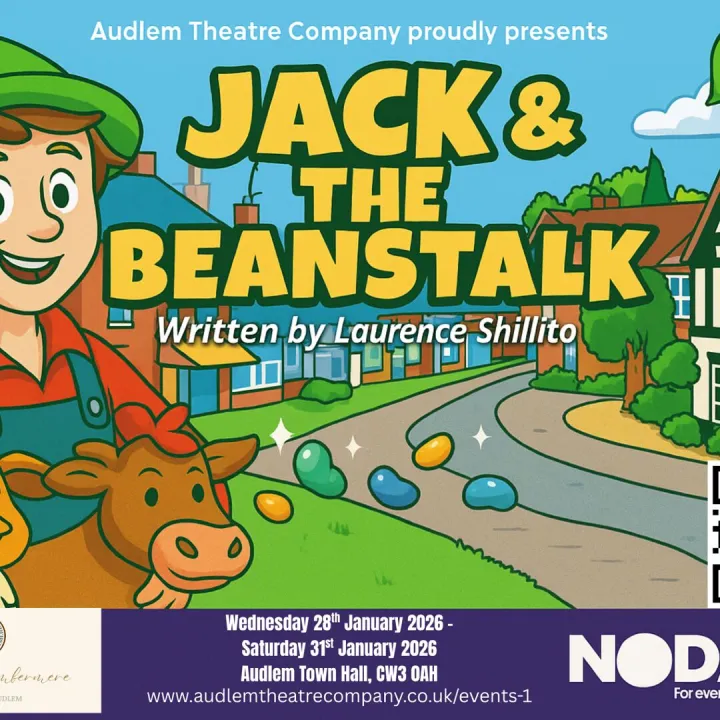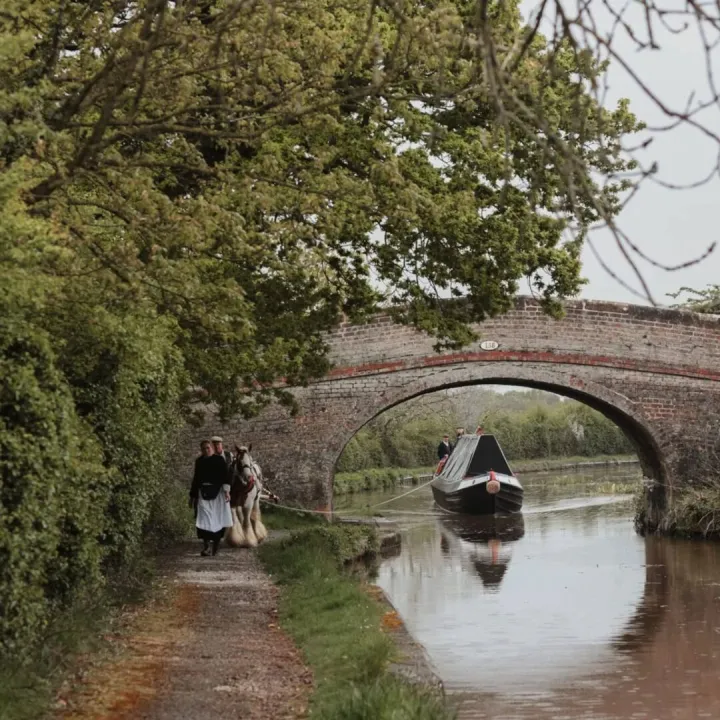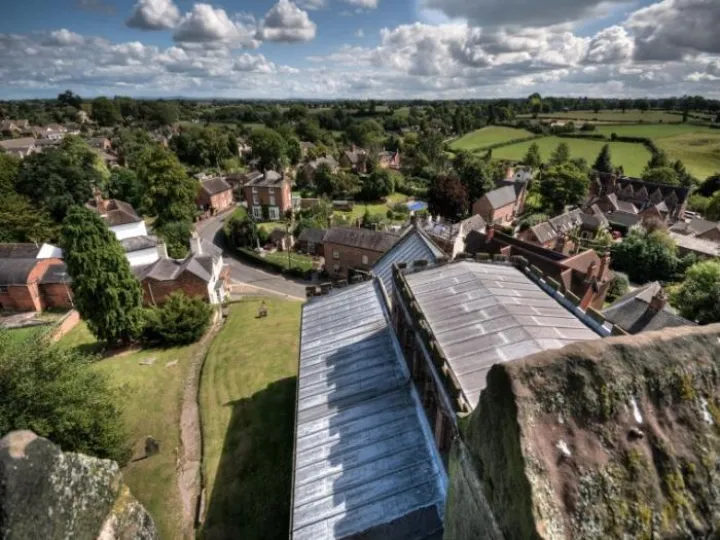







Much of the wealth of Cheshire over the last few centuries has come off the back of the cow, some may argue udderwise... The dairy cow has not only provided milk, for the production of butter and cheese, but also beef calves when put to an appropriate breed of bull; hide for the once thriving Cheshire tanning industry and bones and offal for the finer things in life!
In turn this helped to establish Nantwich as a renowned centre of leather glovemaking by the end of the C18th, which required a high degree of skill involving fine stitch work and led to the establishment of the quality clothing industry in the town, which has just come to a sad demise in the last twelve months.
It's easy to understand what the 'Send a Cow' charity is aiming to achieve in the temperate regions of Africa with it's cow export program, as whole economies can be kick-started from the back of this beautiful, usually benign animal. No wonder that the cow has holy status in India where the general population is more closely associated with the land and all that it provides.
But in the current agricultural climate, what does the future hold for the dairy industry in Cheshire or elsewhere in the country for that matter? It seems as though every time I open a local paper another dairy farm is on the market, destined to fulfil some urban dream with imaginative barn conversion names like 'The Old Cowshed.' Yet the simple fact is that our long established dairy industry is in crisis like never before and yes, I know that, like me, you have heard it all before too. But now that I have no axe to grind it's a pleasant change to be able to view the situation from a more dispassionate angle.
When you get the likes of the Chairman of Waitrose speaking out on behalf of dairy farmers you know things are not going well. The reality is that the principles of Adam Smith and the free market are crucifying the industry and to no good cause. Milk production cannot be turned on and off as a factory production line can. From the rearing of the cow to the time it has flashed its comely udder to the bull, got with calf and eventually produced (hopefully alive) a calf of its own so that milk will flow, we are talking of years not months or days. Add to this the need for a dairy farmer to make an enormous investment of borrowed capital – half a million is not unusual to put up a new parlour and housing complex to meet current animal welfare, hygiene and health and safety standards – and you can begin to understand why farmers are not prepared to get out of bed at some unearthly hour, day after month after year, just to keep the supermarkets and their shareholders happy. So they see the option of cashing in their chips and living off the investment proceeds as the preferred alternative.
This is particularly the case with a new generation of farmers children who have wider horizons than any previous and are, for the most part, simply not prepared even if they could afford it, to work for less than the minimum wage in a job that is both dirty and dangerous. Check the H.S.E. statistics for farm accidents, it's no longer the bucolic lifestyle as once so widely portrayed.
So you say, what's the problem with that? Some farmers will remain in the business, they will either be the keen, sharp business brains who will always make a profit, say from a niche market like organic or on-farm manufacture or from sheer scaling up to perhaps a thousand cows or more. Well, the problem as I see it lays in direct conflict with everything the government, the supermarkets and the green lobby groups say that they are trying to achieve. With a greatly reduced number of dairy farms we will inevitably see much more imported milk coming into our market at times of shortfall unless the supermarkets start to work meaningfully with producers, something that they have paid scant lip service to, up to now. There have been a few exceptions to this, such as M&S; Waitrose and Muller who have established close links with individual farmers in order to ensure quality, trace-ability and continuity of supply but inevitably their prices are tied to the current downward spiral in the marketplace.
Meanwhile, the other slash and burn merchants continue to cut each others throats to put the cheapest possible pinta on the doorstep, seemingly oblivious to the decimation of the traditional production base or what it will mean for the countryside, the workforce or that holiest of all sacred cows, the environment.
The long term implications for the latter are already well in train. With fewer but much larger herds being established across the countryside it will mean that the Cheshire summer landscape, when viewed from the Bickerton Hills, will never again look like a green quilt with black and white appliqué cows grazing contentedly. The new super-herds that are gradually being assembled will soon be too big to send out to graze. Just imagine how much mud a thousand cow herd will generate going through a gateway, let alone the sheer time involved in getting them all in again. Most of us have whiled away the odd hour or so of our lives waiting for the cows to cross some road or other and that's with the small herds of yesterday. The result is that these future herds will be ambient sofa lovers, having all their worldly wants transported to their very hooves, never having the curtains drawn back for fear of a draught or an unwelcome thought like a green and beckoning world beyond. Truly the urban cow.
And what does this leap forward in dairying achieve in terms of the Government's 'Green Agenda'? Instead of the cows walking to their field, we transport the field, in terms of cut grass, to them, burning hydrocarbons to do so. Large numbers of cows all concentrated in one small area can produce challenges in terms of disease control, but fortunately our vets have a wide range of antibiotics to control the situation and they will probably need all of them. Wherever you have cows housed on concrete yards you have slurry, lots of it. This will have to be carted out by large vehicles for long distances as the pollution control regulations justifiably restrict the amount of slurry that can be applied per hectare, burning yet more fuel.
And the size of the machines required to service these new super herds will be commensurate, their large bulk and speed adding to the natural hazards of our already overburdened and under funded country lanes. Down by the 'Old Cowshed,' the nauseous stench of long-stored slurry (it can only now be applied at certain times of the year) has a cauterising effect on all but the nasally challenged. Can you imagine, poor dears, their long cherished dream of a house in the country, surrounded by fields of wild flowers, now destroyed by the reality of a harsh, machine dominated landscape.
So this is the way forward for much of our countryside and dairy industry as dictated by the free market strategy of successive governments and supermarket connivance. The situation is an unfolding disaster upon our farmers, our environment and the quality of life of all who live and work here, not to mention the animals themselves. If the cows don't need to go out, why do they need legs? The answer lies in the test tube.
But all is not lost – it can surely only be a matter of time before some enterprising young artist, eyes focussed on winning the Turner prize, comes up with the idea of placing plastic cows in our Cheshire fields to replicate the good old days. But will it fit in the Turbine Hall at Tate Modern?
This article is from our news archive. As a result pictures or videos originally associated with it may have been removed and some of the content may no longer be accurate or relevant.
Get In Touch
AudlemOnline is powered by our active community.
Please send us your news and views using the button below:
Email: editor@audlem.org





